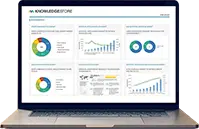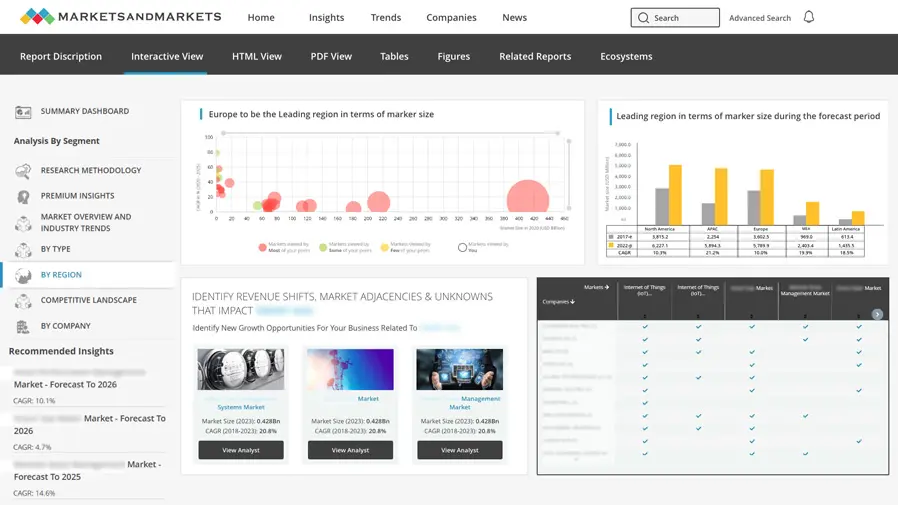Rotary Screw Compressor Market - Global Forecast to 2029
The Rotary Screw Compressor market is anticipated to grow from USD 10.10 billion in 2024 to USD 13.45 billion by 2029 with a CAGR of 5.9% during 2024-2029. The rotary screw compressor market is one of the key segments of the broader landscape for global industrial equipment, with demand across sectors in which there is a need for efficient and reliable compressed air systems. They have established their benefits in their ability to operate continuously and efficiently with a reduced energy consumption rate, and therefore, are found to be indispensable in manufacturing, construction, and automotive, as well as critical applications in healthcare and food processing. Changes are continuing in this market segment, which is innovating in energy-efficient solutions, environmental compliance, and smart technologies, answering the need for adaptable solutions in many end-use sectors.
Based on Type segment, the Rotary Screw Compressor market has been categorized as oil free, and oil injected. For heavy-duty applications for manufacturing, construction, and automotive industries, oil-injected compressors are seen to be most efficient and cost-effective. It mixes with the compressed gas to lubricate, cool, and seal screw rotors and allows usage of downstream filtration systems to remove oil contaminants from compressed air. For the oil-free compressors, this air purified from oil in the compression chamber is clean, thereby becoming crucial for industries such as pharmaceuticals, food and beverage, and electronics. These are usually expensive initially, as they save on air purification because of sustainability and compliance goals on the sensitive sectors. Both technologies have markets that differ but are weighed against efficiency, cost, and quality of air. The enhanced efficiency and cost-effectiveness that derive from oil-injected compressors make them suitable for very heavy applications like manufacturing, construction, and automotive. It uses oil during the compression process to lubricate, cool, and seal the screws. However, oil-imprisoned compressors cannot function without a downstream filtration system, which eliminates all oil contaminations from the compressed air. Whereas, if it does not have oil in the compression chamber, oil-free compressors will offer air free of contaminants. Hence, it is an irreplaceable partner in industries like pharmaceuticals, food and beverages, and electronics, where the air should remain clean. These compressors are perhaps more expensive in initial costs. However, extensive purification of air is avoided. These are also in line with sustainability and compliance goals of sensitive sectors. These two technologies meet demands of the specific markets in terms of efficiency, cost, and quality in air.
In Stage segment, the Rotary Screw Compressor market has been segmented as single stage, and multi stage. A single-stage compressor compresses the air in a single step. These compressors are less complex, cheaper, and are designed to serve applications that require low and medium pressure levels, such as small workshops and low-demand industrial processes. Multi-stage compressors compress air in multiple stages to produce higher pressures, and they are more energy efficient in their application, ranging from large petrochemical to power generation and heavy manufacturing processes. Multi-stage systems normally generate less heat and have better durability, making them effective at continuous operations under high pressures. Such segmentation indicates the wide variety of needs when performance or cost is concerned, all in the effort of optimizing the use of resources.
A few of the players operating in the Rotary Screw Compressor market include Atlas Copco (Sweden), Ingersoll Rand Inc. (Ireland), Siemens AG (Germany), Gardner Denver Holdings Inc. (USA), Sullair LLC (USA), Kaeser Kompressoren (Germany), Elgi Equipment (India), Bauer Kompressoren (Germany), and Man Energy Solutions (Germany) among others.

1 INTRODUCTION
1.1. OBJECTIVE OF THE STUDY
1.2. MARKET DEFINITION
1.3. INCLUSIONS AND EXCLUSIONS
1.4. MARKET SCOPE
1.4.1. MARKET SEGMENTATION
1.4.2. REGIONAL SCOPE
1.5. YEARS CONSIDERED
1.6. CURRENCY
1.7. LIMITATIONS
1.8. STAKEHOLDERS
2 RESEARCH METHODOLOGY
2.1. RESEARCH DATA
2.2. MARKET BREAKDOWN AND DATA TRIANGULATION
2.2.1. SECONDARY DATA
2.2.1.1. KEY DATA FROM SECONDARY SOURCES
2.2.2. PRIMARY DATA
2.2.2.1. KEY DATA FROM PRIMARY SOURCES
2.2.2.2. KEY INDUSTRY INSIGHTS
2.2.2.3. BREAKDOWN OF PRIMARY INTERVIEWS
2.3. MARKET SIZE ESTIMATION
2.3.1. BOTTOM-UP APPROACH
2.3.2. TOP-DOWN APPROACH
2.3.3. DEMAND SIDE ANALYSIS
2.3.3.1. ASSUMPTIONS FOR DEMAND SIDE ANALYSIS
2.3.3.2. DEMAND SIDE CALCULATION
2.3.4. SUPPLY-SIDE ANALYSIS
2.3.4.1. ASSUMPTIONS FOR SUPPLY SIDE ANALYSIS
2.3.4.2. SUPPLY-SIDE CALCULATION
2.4. FORECAST
2.4.1. RESEARCH ASSUMPTIONS
2.4.2. LIMITATIONS OF RESEARCH
2.4.3. RISK ASSESSMENT
3 EXECUTIVE SUMMARY
4 PREMIUM INSIGHTS
5 MARKET OVERVIEW
5.1. INTRODUCTION
5.2. MARKET DYNAMICS
5.2.1. DRIVERS
5.2.2. RESTRAINTS
5.2.3. OPPORTUNITIES
5.2.4. CHALLENGES
5.3. CASE STUDY ANALYSIS
5.4. TRENDS/DISRUPTIONS IMPACTING CUSTOMER’S BUSINESS
5.5. VALUE/SUPPLY CHAIN ANALYSIS
5.6. ECOSYSTEM
5.7. PRICING ANALYSIS
5.8. PATENT ANALYSIS
5.9. REGULATORY LANDSCAPE
5.9.1. REGULATORY BODIES, GOVERNMENT AGENCIES, AND OTHER ORGANIZATIONS
5.9.2. REGULATORY FRAMEWORK
5.10. PORTER’S FIVE FORCES ANALYSIS
5.11. KEY STAKEHOLDERS AND BUYING CRITERIA
5.11.1. KEY STAKEHOLDERS IN BUYING PROCESS
5.11.2. BUYING CRITERIAe
6 ROTARY SCREW COMPRESSOR MARKET, BY TECHNOLOGY
(Value (USD Million) – 2021, 2022, 2023, 2024-e, 2029-f)
6.1. INTRODUCTION
6.2. STATIONARY
6.3. PORTABLE
7 ROTARY SCREW COMPRESSOR MARKET, BY STAGE
(Value (USD Million) – 2021, 2022, 2023, 2024-e, 2029-f)
7.1. INTRODUCTION
7.2. SINGLE STAGE
7.3. MULTI STAGE
8 ROTARY SCREW COMPRESSOR MARKET, BY TYPE
(Value (USD Million) – 2021, 2022, 2023, 2024-e, 2029-f)
8.1. INTRODUCTION
8.2. OIL-FREE
8.3. OIL-INJECTED
9 ROTARY SCREW COMPRESSOR MARKET, BY END USER
(Value (USD Million) – 2021, 2022, 2023, 2024-e, 2029-f)
9.1. INTRODUCTION
9.2. CHEMICAL & PETROCHEMICAL
9.3. FOOD & BEVERAGE
9.4. MINING & METAL
9.5. OIL & GAS
9.6. AUTOMOTIVE
9.7. MEDICAL & PHARMACEUTICAL
9.8. OTHERS
10 ROTARY SCREW COMPRESSOR MARKET, BY REGION
(Value (USD Million) – 2021, 2022, 2023, 2024-e, 2029-f)
10.1. INTRODUCTION
10.2. NORTH AMERICA
10.2.1. BY TECHNOLOGY
10.2.2. BY TYPE
10.2.3. BY STAGE
10.2.4. BY END USER
10.2.5. BY COUNTRY
10.2.5.1. US
10.2.5.1.1. BY END USER
10.2.5.2. CANADA
10.2.5.3. MEXICO
10.3. ASIA PACIFIC
10.3.1. BY TECHNOLOGY
10.3.2. BY TYPE
10.3.3. BY STAGE
10.3.4. BY END USER
10.3.5. BY COUNTRY
10.3.5.1. CHINA
10.3.5.1.1. BY END USER
10.3.5.2. INDIA
10.3.5.3. JAPAN
10.3.5.4. AUSTRALIA
10.3.5.5. REST OF ASIA PACIFIC
10.4. EUROPE
10.4.1. BY TECHNOLOGY
10.4.2. BY TYPE
10.4.3. BY STAGE
10.4.4. BY END USER
10.4.5. BY COUNTRY
10.4.5.1. GERMANY
10.4.5.1.1. BY END USER
10.4.5.2. UK
10.4.5.3. SPAIN
10.4.5.4. FRANCE
10.4.5.5. REST OF EUROPE
10.5. SOUTH AMERICA
10.5.1. BY TECHNOLOGY
10.5.2. BY TYPE
10.5.3. BY STAGE
10.5.4. BY END USER
10.5.5. BY COUNTRY
10.5.5.1. BRAZIL
10.5.5.1.1. BY END USER
10.5.5.2. ARGENTINA
10.5.5.3. REST OF SOUTH AMERICA
10.6. MIDDLE EAST & AFRICA
10.6.1. BY TECHNOLOGY
10.6.2. BY TYPE
10.6.3. BY STAGE
10.6.4. BY END USER
10.6.5. BY COUNTRY
10.6.5.1. GCC
10.6.5.1.1.1. BY END USER
10.6.5.1.2. SAUDI ARABIA
10.6.5.1.3. UAE
10.6.5.1.4. REST OF GCC
10.6.5.2. SOUTH AFRICA
10.6.5.3. REST OF MIDDLE EAST AND AFRICA
11 COMPETITIVE LANDSCAPE
11.1. KEY PLAYER STRATEGIES OVERVIEW
11.2. MARKET SHARE ANALYSIS OF KEY PLAYERS, 2023
11.3. REVENUE ANALYSIS OF TOP 5 PLAYERS, 2019-2023
11.4. COMPETITIVE SCENARIO AND TRENDS
11.5. COMPANY VALUATION AND FINANCIAL METRICS
11.6. COMPANY EVALUATION MATRIX: KEY PLAYERS, 2023
11.6.1. STARS
11.6.2. EMERGING LEADERS
11.6.3. PERVASIVE PLAYERS
11.6.4. PARTICIPANTS
11.6.5. COMPANY FOOTPRINT: KEY PLAYERS, 2023
11.6.5.1. Company Footprint
11.6.5.2. Type Footprint
11.6.5.3. Technology Footprint
11.6.5.4. Stage Footprint
11.6.5.5. Region Footprint
12 COMPANY PROFILES
12.1. ATLAS COPCO
12.1.1. Business Overview
12.1.2. Products Offered
12.1.3. Recent Developments
12.1.4. MnM view
12.1.4.1. Key strategies/right to win
12.1.4.2. Strategic choices made
12.1.4.3. Weaknesses and competitive threats
12.2. INGERSOLL RAND INC.
12.3. SIEMENS AG
12.4. GARDNER DENVER HOLDINGS INC.
12.5. SULLAIR LLC
12.6. KAESER KOMPRESSOREN
12.7. ELGI EQUIPMENT
12.8. BAUER KOMPRESSOREN
12.9. MAN ENERGY SOLUTIONS
12.10. CHART INDUSTRIES
13 APPENDIX
13.1. INSIGHTS OF INDUSTRY EXPERTS
13.2. DISCUSSION GUIDE
13.3. KNOWLEDGESTORE: MARKETSANDMARKETS’ SUBSCRIPTION PORTAL
13.4. CUSTOMIZATION OPTIONS
13.5. RELATED REPORTS
13.6. AUTHOR DETAILS















Growth opportunities and latent adjacency in Rotary Screw Compressor Market